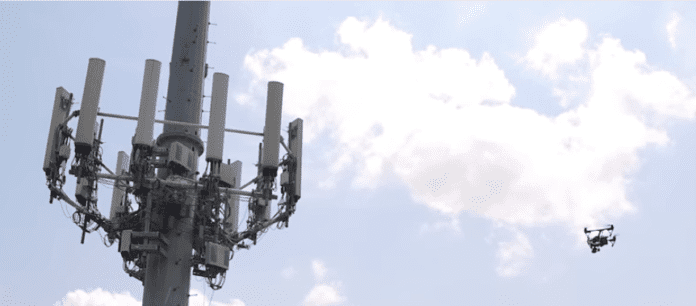AT&T said its recent trials of drones as surrogate tower climbers have been highly successful, and that it plans to be using drones in its tower operations by the end of September.
“Every time we use a drone it’s just one less tower climb. Every tower climb that we can save provides a safer situation, or less opportunity for potential injury,” said Art Pregler, director of national mobility systems at AT&T. Pregler does not see drones completely replacing tower climbers, but he does believe drones will lead to a more efficient use of climbers over time.
Pregler said drones also add efficiency to the process of inspecting a tower before an upgrade or repair. Drones can send live video to desktop computers on the ground, and tower technicians can direct the drone to get more images of a tower trouble spot in real time. These images tell tower crews what the top of the tower looks like so they can take the right equipment when they climb.
The drones capture hundreds of images which are georeferenced and fed into 3D modeling software. AT&T uses the models to measure antenna height, downtilt and azimuth.
“We’re seeing very accurate results from this data,” said Pregler. “We obtain it faster and we obtain it with more accuracy than we’ve been able to do with traditional methods. … For example, instead of having to watch an entire video to understand what it is you’re looking at, we can tag all the various elements within there, so if we want to see for example … a certain antenna or a certain radio, we can click on that tag and it takes us right to that spot.”
Preinstallation inspections and birds’ nest evaluation are currently the two most common uses for drones at AT&T tower sites. Keeping climbers off towers when protected species may be nesting there has two advantages: it protects climbers from potentially aggressive birds guarding eggs or hatchlings and it avoids inadvertent disruption of a nest, since drones don’t touch the towers.
“We’re not allowed to perform work on towers if there’s active nesting by an endangered bird, so we can fly the drone and inspect the nest without having to climb the tower, and know definitively if the bird is nesting,” Pregler said.
Other important use cases for drones include disaster recovery, post-installation inspections, stadium distributed antenna system drive testing, and microwave testing. Disaster recovery involves flying a drone to a site where a natural disaster has impacted a tower to see if it is possible to safely access the site. Post-installation inspections are often done by AT&T’s contractors who work on its tower sites. Stadium DAS drive testing is radio frequency testing in a stadium environment, and microwave testing is flying a drone to a link location and photographing the other side of the microwave link to see if there is any obstruction.
Leveraging the drone investment
AT&T works with a number of vendors providing drone services, and Pregler believes that the work AT&T is doing with these vendors could benefit other industries in the future. He hopes AT&T can leverage not only its cellular network but also its network of drone vendors to help enterprise customers take advantage of this technology.
“In addition to internal use, we’re looking at how to use our network across all industries,” said Pregler. “Civil infrastructure, agriculture, real estate, utilities … basically all the industries out there that could conceivably use drones, and then use our network to manage that.”
AT&T also is looking at drones as miniature LTE base stations that could be flown into crowded areas to boost capacity, and is working with Intel to use drones to test the performance of the LTE network at high altitudes, with the goal of finding out how altitude impacts video streaming and telematics.
For more information on the use of drones at tower sites, see our recent tower technology report and webinar.
Follow me on Twitter.

